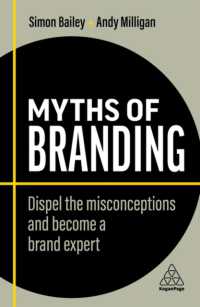基本説明
Drawing on research and theory in applied linguistics, their focus is strongly hands-on, featuring easily applied principles, a large number of useful teaching techniques, and guidelines for testing and monitoring. All Certificate, Diploma, Masters and Doctoral courses for teachers of English as a second or foreign language include a teaching methods component. The texts are designed for and have been field tested in such programs.
Full Description
Using a framework based on principles of teaching and learning, this guide for teachers and teacher trainees provides a wealth of suggestions for helping learners at all levels of proficiency develop their reading and writing skills and fluency. By following these suggestions, which are organized around four strands - meaning-focused input, meaning-focused output, language-focused learning, and fluency development - teachers will be able to design and present a balanced program for their students.Teaching ESL/EFL Reading and Writing, and its companion text, Teaching ESL/EFL Listening and Speaking, are similar in format and the kinds of topics covered, but do not need to be used together. Drawing on research and theory in applied linguistics, their focus is strongly hands-on, featuring easily applied principles,a large number of useful teaching techniques, andguidelines for testing and monitoring,All Certificate, Diploma, Masters and Doctoral courses for teachers of English as a second or foreign language include a teaching methods component. The texts are designed for and have been field tested in such programs.
Contents
@contentsTable of ContentsChapter 1 Learning to read in another language 1Learning to read in the first languageLearning to read in another languagePrinciples for teaching readingChapter 2 Learning to recognise and spell words Prerequisites for formal reading instructionPhonics and the alphabetic principleThe role of phonics in a reading programmeSpelling: productive phonicsLearning to spellDesigning a focused spelling programmeChapter 3 Intensive reading Focuses in intensive readingFeatures of a good reading exerciseAre comprehension questions good reading exercises?Comprehension of the textThe focus of comprehension questionsGrammar features in the textCohesive devicesStrategy developmentStandardized reading proceduresHandling the exercisesThe role of teaching exercisesChapter 4 Extensive reading Understand the goals and limitations of extensive readingFind your learners= present vocabulary levelProvide plenty of interesting and appropriate reading textsSet, encourage and monitor large quantities of extensive readingSupport and supplement extensive reading with language focused learning and fluency developmentHelp learners move systematically through the graded reader levelsSimplified and unsimplified textsThe extensive reading programmeChapter 5 Reading faster The nature and limits of reading speedThe nature of fluency developmentThe nature of fluency development activitiesIncreasing oral reading speedIncreasing careful silent reading speedIncreasing silent expeditious reading speedFrequently asked questions about reading speedChapter 6 Assessing reading MotivatingMeasuring achievementDiagnosing problemsMeasuring reading proficiencyIssues in making and using comprehension testsChapter 7 Helping learners write Principles for teaching writingDesigning tasksExperience tasksBringing tasks within the learners' experienceMaking sure learners have the experience to do a taskShared tasksGuided tasksIndependent tasksUsing the four kinds of tasksChapter 8 The writing process The parts of a writing programmeMeaning-focused writingThe parts of the writing processConsidering the goals of the writer and model of the readerGathering ideasIdeas to textEditingReviewingDiagnosing control of the parts of the writing processDiagnosing from the written productChapter 9 Topic types The topic type hypothesisTopic types and writingTopic types and readingLimitations of the topic type approachChapter 10 Responding to written work MotivatingImproving the quality of writingMeasuring proficiency in writingAppendix 1 Spelling correspondences Appendix 2 Conjunction relationships References








